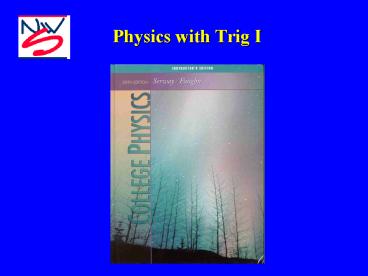Physics with Trig I PowerPoint PPT Presentation
1 / 14
Title: Physics with Trig I
1
Physics with Trig I
2
Where weve been
- Newtons Laws of Motion
- Work Energy
- Conservation of Momentum
- Circular Motion Gravity
- Torque Angular Acceleration
- Solids Fluids
- The Ideal Gas Law
- Thermal Physics
3
Ch 11 Introduction
Heat was once considered to be a mystical fluid
called caloric, that could be made to flow from
once substance to another. It is now recognized
to be energy, and is specifically defined as
energy transfer due to a temperature
difference. The first law of thermodynamics is
the law of conservation of energy and as such
includes all forms of energy including thermal
energy.
4
Where were going
Ch 11 Heat (11.1) The Mechanical Equivalent of
Heat (11.2) Heat Capacity (11.3) Conservation of
Energy (11.4) Latent Heat Phase Changes (11.5)
Heat Transfer by Conduction (11.6)
Convection (11.7) Radiation (11.8) Resistance to
Heat Transfer
5
(11.1) The Mechanical Equivalent of Heat
- Heat (Thermal Energy)
- An energy transfer due to a ?Temp
- Units
- calorie (cal)
- Amount of heat needed to raise 1 g water from
14.5 o C to 15.5 o C - Calorie (Cal) the food Calorie ( 1 k cal)
- Btu ( British Thermal Unit)
- Amount of heat needed to raise 1 LB water from 63
o F to 64 o F
6
(11.2) Heat Capacity
Heat Capacity (C) amount of heat energy needed
to raise Temp of a substance by 1 oC
Specific Heat Capacity
See Table 11.1, page 335
7
(11.2) Heat Capacity, contd
Amount of Thermal Energy (Q) needed to raise, or
lower, temperature of a mass
Problem 11.6
8
(11.3) Conservation of Energy (Calorimetry)
Energy lost by body A equals energy gained by
body B. That is, ? E 0
Problem 11.13
9
(11.4) Latent Heat Phase Changes
10
(11.4) Latent Heat Phase Changes, contd
L fusion occurs at solid-liquid interface L
vaporization occurs at liquid-vapor
interface Example 1.00 kg of ice at 10.0 oC
? vapor at 100 oC
? ()
11
(11.5) Heat Transfer by Conduction
k ? thermal conductivity of a material A ?
surface area of material conducting heat (-)
Thermal energy flows in direction of decreasing
Temp (hot to less hot)
12
(11.5) Heat Transfer by Conduction, contd
Where L ? thickness of material k ? thermal
conductivity R ? R Value of insulation
13
(11.5) Heat Transfer by Conduction, contd
This problem is NOT in your text Compare Heat
loss (H) for single and double-pane window with
these specs Window size 36 in. by 60 in. ? T
(70 oF 40 oF) 30 oF
14
The End

